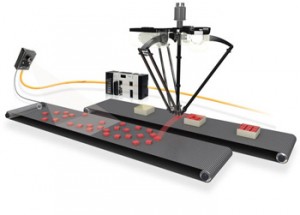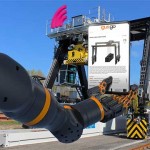Working with robots simply as automation components
 Machine builders facing ever increasing pressures to deliver machines that address requirements for increased productivity and reduced costs are coming to see the potential for robotic solutions. And the good news, says Omron’s Robert Brooks, is that today robots can be treated as standard automation components, easily integrated into production lines.
Machine builders facing ever increasing pressures to deliver machines that address requirements for increased productivity and reduced costs are coming to see the potential for robotic solutions. And the good news, says Omron’s Robert Brooks, is that today robots can be treated as standard automation components, easily integrated into production lines.
When we think about robots in automation, it tends to be images of large six-axis robots working in assembly, welding and painting operations in car plants. Whilst it is true that the automotive industry is a major user of robot technology, there are many more opportunities outside of this sector, in areas such as food, pharmaceuticals, electronics and packaging where fast, flexible robots can add value to just about any pick and place operation. Robots are reliable, ensure consistent product quality, reduce costs, improve safety, improve efficiency and reduce waste. Importantly in modern production environments, they can significantly improve flexibility to handle different product sizes and varieties. And they enable a redistribution of labour around a plant that helps to add value to the whole business.
Machine builders who embrace robots as an integral part of their automation platform can reap benefits, too, perhaps replacing more complex or less flexible electromechanical systems, or adding robots to an existing machine design to increase flexibility, or perhaps using them as the product handling link between two machines.
The benefits of robots are widely acknowledged, but traditionally there have been significant barriers to their adoption. First of these was cost, with robots tending to be viewed only in terms of their high purchase price and with little regard for their impact on productivity and thus on total cost of ownership. The second objection was complexity, with robots traditionally needing specialist programming and application support. This added to the overall cost, and inevitably limited the flexibility of deployment.
With the latest generations of robots, combined with new strategies for programming that enable robots to be treated in the same way – and within the same software – as other automation components, all of the traditional objections have now been overcome. It is now both easy and cost-effective to integrate robots into single machines or complete production lines, opening up a raft of benefits for both machine builders and their end user customers.
Omron has long offered SCARA robots for loads up to 50kg, with a choice of more than 70 models, but now the company has introduced a delta robot range, promising pick and place cycle times of 150 cycles per minute for loads up to 2kg – ideal for a host of applications within industries such as packaging, food, pharmaceuticals and electronics. Importantly, these delta robots have been developed as part of Omron’s Sysmac platform, seamlessly integrating robotics with motion, PLCs, safety and vision, and all programmed within the same software package. Not only does this significantly reduce any learning curve, it also has huge implications for service and support.
The robotic aspect of the machine can now be treated just like any other servo axis, and all of these axes can sit on the same common bus system and connect to the same controller. Again, there is just one product to learn: if you’re comfortable with the servos, you’ll be comfortable with the robots. The combination of high performance servo motors with the kinematics of delta robots allows maximum throughput to be achieved in pick and place applications. For example, Omron’s Sysmac NJ delta controller enables up to eight delta robots to be used, and can synchronise up to 64 axes of motion, keeping control of all the motion devices in the machine. Not only does this simplify set up, but the ability to use a single controller with multiple robots also keeps costs low and reduces panel space requirements.
The synchronisation of multiple machines or lines can be fully programmed thanks to a powerful command set developed especially for pick and place applications that use delta robots. With Omron’s product range, programming is to IEC 61131-3 standards, and is carried out within the Sysmac Studio software package – the same package you’ll use to program all your other Sysmac components. The software includes a comprehensive robotics library to make it simple to set up sophisticated robot motion profiles. Integration with other Sysmac components is via on-board EtherCAT, with an EtherNet/IP port also included for communications with higher level systems.
Many machine applications require products to be ‘seen’ and ‘tracked’, which implies a need for integrated vision. The ability to integrate vision easily gives robots the sight they need for high speed, high accuracy pick and place operations. When that vision system can be programmed and configured within the same software environment as every other part of the automation system, machine builders again benefit from reduced complexity, reduced integration effort, reduced cost and simpler support.
Another benefit of this new approach to robot integration is increased flexibility. Ease of programming means robots can be easily reconfigured for different applications on a production line, or easily redeployed in different areas of the plant entirely. For sectors such as the packaging industry, this increased flexibility is a major boon.
To truly reap the benefits of robots, machine builders need to be free to choose the right style of robot for a given application. This might be a SCARA robot or it might be a delta robot, but choice will be based on factors such as payload, cycle time, environment and movement profile. By offering a wide choice of robots in different ranges, Omron is well placed to meet the needs of machine builders, delivering on the promise of increased productivity and increased accuracy, with assured ease of programming.
Visit the Omron website for more information
See all stories for Omron















